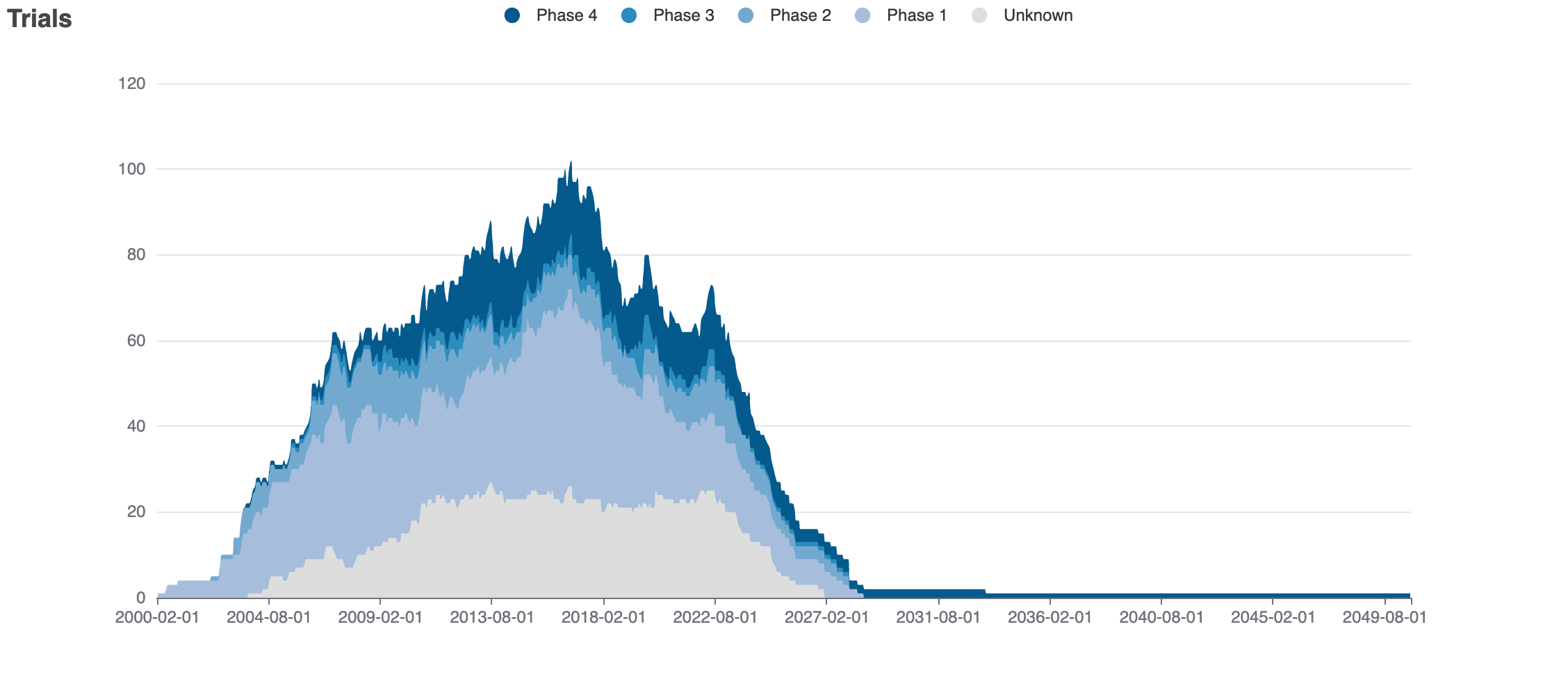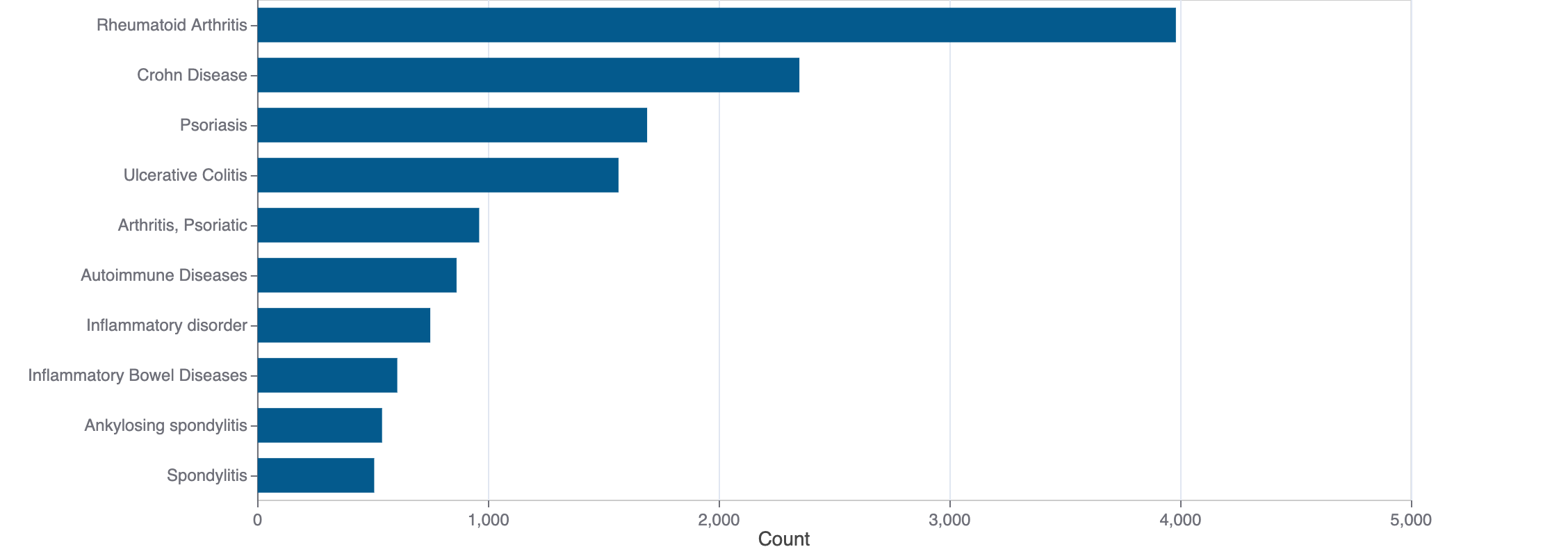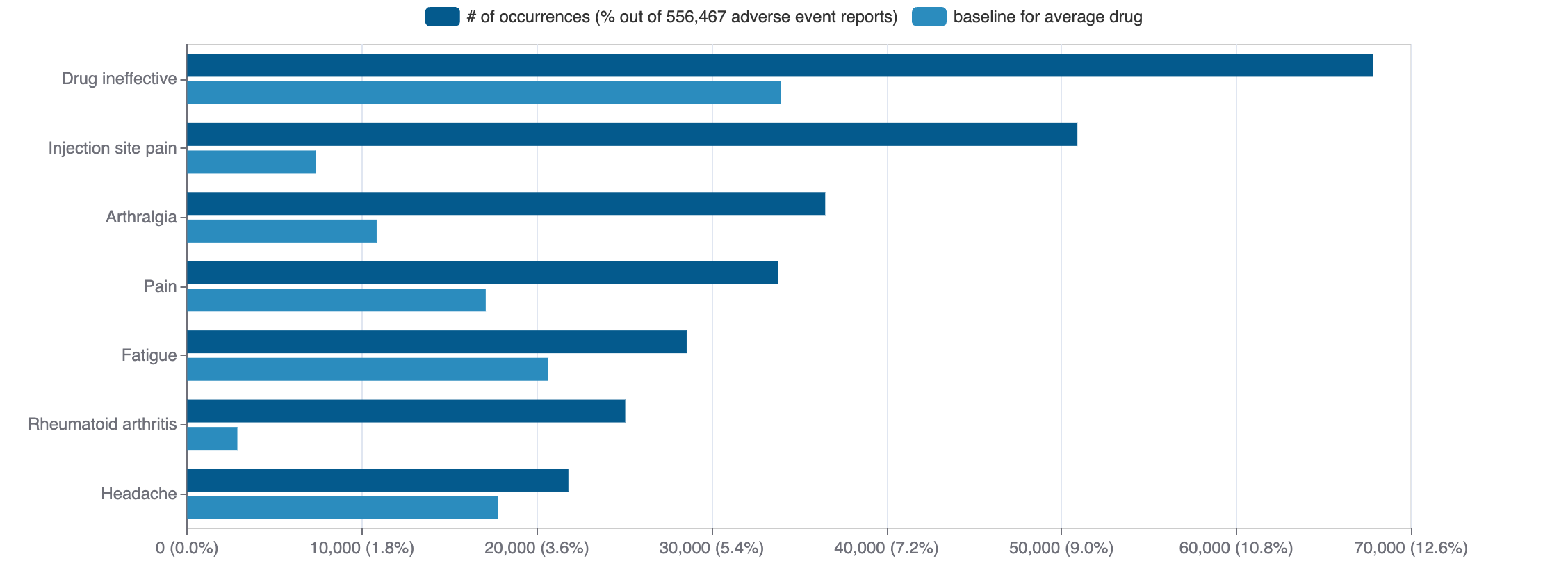Tesevatinib
Tesevatinib is a small molecule pharmaceutical. It is currently being investigated in clinical studies. The pharmaceutical is active against receptor tyrosine-protein kinase erbB-2, vascular endothelial growth factor receptor 3, epidermal growth factor receptor, vascular endothelial growth factor receptor 2, and ephrin type-B receptor 4.
Download report
Favorite
Events Timeline
Commercial
Clinical
Drug
Target
Variants
Financial
Trends
Safety
Events Timeline
5D
1M
3M
6M
YTD
1Y
2Y
5Y
Max
Events
FDA approval date
EMA approval date
Patent expiration date
Study first post date
Last update post date
Start date
Primary completion date
Completion date
Results first post date

Mock data
Subscribe for the real data
Subscribe for the real data
Commercial
No data
Clinical
Clinical Trials
15 clinical trials
View more details

Mock data
Subscribe for the real data
Subscribe for the real data
Indications Phases 4
No data
Indications Phases 3
Indication | MeSH | Ontology | ICD-10 | Ph 1 | Ph 2 | Ph 3 | Ph 4 | Other | Total |
|---|---|---|---|---|---|---|---|---|---|
| Non-small-cell lung carcinoma | D002289 | — | — | 1 | 3 | 1 | — | — | 5 |
Indications Phases 2
Indication | MeSH | Ontology | ICD-10 | Ph 1 | Ph 2 | Ph 3 | Ph 4 | Other | Total |
|---|---|---|---|---|---|---|---|---|---|
| Polycystic kidney diseases | D007690 | — | Q61.3 | 2 | 3 | — | — | — | 4 |
| Brain neoplasms | D001932 | EFO_0003833 | C71 | 1 | 3 | — | — | — | 3 |
| Autosomal dominant polycystic kidney | D016891 | EFO_1001496 | Q61.2 | 1 | 3 | — | — | — | 3 |
| Kidney diseases | D007674 | EFO_0003086 | N08 | 2 | 2 | — | — | — | 3 |
| Breast neoplasms | D001943 | EFO_0003869 | C50 | 2 | 1 | — | — | — | 2 |
| Lung neoplasms | D008175 | — | C34.90 | — | 2 | — | — | — | 2 |
| Arthrogryposis | D001176 | EFO_0003857 | Q74.3 | 1 | 2 | — | — | — | 2 |
| Recurrence | D012008 | — | — | — | 1 | — | — | — | 1 |
| Glioblastoma | D005909 | EFO_0000515 | — | — | 1 | — | — | — | 1 |
| Second primary neoplasms | D016609 | — | — | — | 1 | — | — | — | 1 |
Show 2 more
Indications Phases 1
Indication | MeSH | Ontology | ICD-10 | Ph 1 | Ph 2 | Ph 3 | Ph 4 | Other | Total |
|---|---|---|---|---|---|---|---|---|---|
| Neoplasms | D009369 | — | C80 | 3 | — | — | — | — | 3 |
| Stomach neoplasms | D013274 | EFO_0003897 | C16 | 1 | — | — | — | — | 1 |
| Esophageal neoplasms | D004938 | — | C15 | 1 | — | — | — | — | 1 |
| Leukemia | D007938 | — | C95 | 1 | — | — | — | — | 1 |
| Lymphoma | D008223 | — | C85.9 | 1 | — | — | — | — | 1 |
| Precursor cell lymphoblastic leukemia-lymphoma | D054198 | — | C91.0 | 1 | — | — | — | — | 1 |
| B-cell lymphoma | D016393 | — | — | 1 | — | — | — | — | 1 |
| Precursor t-cell lymphoblastic leukemia-lymphoma | D054218 | — | — | 1 | — | — | — | — | 1 |
| Lymphoid leukemia | D007945 | — | C91 | 1 | — | — | — | — | 1 |
| Autosomal recessive polycystic kidney | D017044 | — | Q61.1 | 1 | — | — | — | — | 1 |
Indications Without Phase
No data
Epidemiology
Epidemiological information for investigational and approved indications
View more details
Drug
General
| Drug common name | Tesevatinib |
| INN | tesevatinib |
| Description | Tesevatinib is a member of the class of quinazolines that is quinazoline substituted by (3,4-dichloro-2-fluorophenyl)amino, methoxy, and [(3aR,5r,6aS)-2-methyloctahydrocyclopenta[c]pyrrol-5-yl]methoxy groups at positions 4, 6 and 7, respectively. It is a multi-target tyrosine kinase inhibitor of EGFR, ErbB2, KDR, Flt4 and EphB4 and exhibits anti-cancer properties. It has a role as an antineoplastic agent, an EC 2.7.10.1 (receptor protein-tyrosine kinase) inhibitor and an epidermal growth factor receptor antagonist. It is a member of quinazolines, an aromatic ether, a member of monofluorobenzenes, a dichlorobenzene, a secondary amino compound, a diether and a tertiary amino compound. |
| Classification | Small molecule |
| Drug class | tyrosine kinase inhibitors |
| Image (chem structure or protein) |  |
| Structure (InChI/SMILES or Protein Sequence) | COc1cc2c(Nc3ccc(Cl)c(Cl)c3F)ncnc2cc1OC[C@@H]1C[C@@H]2CN(C)C[C@@H]2C1 |
Identifiers
| PDB | — |
| CAS-ID | 781613-23-8 |
| RxCUI | — |
| ChEMBL ID | CHEMBL3544983 |
| ChEBI ID | — |
| PubChem CID | 10458325 |
| DrugBank | DB11973 |
| UNII ID | F6XM2TN5A1 (ChemIDplus, GSRS) |
Target
Agency Approved
ERBB2
ERBB2
FLT4
FLT4
EGFR
EGFR
KDR
KDR
EPHB4
EPHB4
Organism
Homo sapiens
Gene name
ERBB2
Gene synonyms
HER2, MLN19, NEU, NGL
NCBI Gene ID
Protein name
receptor tyrosine-protein kinase erbB-2
Protein synonyms
c-erb B2/neu protein, CD340, herstatin, human epidermal growth factor receptor 2, Metastatic lymph node gene 19 protein, MLN 19, neuro/glioblastoma derived oncogene homolog, neuroblastoma/glioblastoma derived oncogene homolog, p185erbB2, Proto-oncogene c-ErbB-2, Proto-oncogene Neu, Tyrosine kinase-type cell surface receptor HER2, v-erb-b2 avian erythroblastic leukemia viral oncogene homolog 2, v-erb-b2 avian erythroblastic leukemia viral oncoprotein 2, v-erb-b2 erythroblastic leukemia viral oncogene homolog 2, neuro/glioblastoma derived oncogene homolog
Uniprot ID
Mouse ortholog
Erbb2 (13866)
receptor tyrosine-protein kinase erbB-2 (Q6ZPE0)
Alternate
No data
Variants
No data
Financial
No data
Trends
PubMed Central
Top Terms for Disease or Syndrome:

Mock data
Subscribe for the real data
Subscribe for the real data
Additional graphs summarizing 210 documents
View more details
Safety
Black-box Warning
No Black-box warning
Adverse Events
© 2020-2025 Collaborative Drug Discovery Inc. (CDD) | Terms of Use
